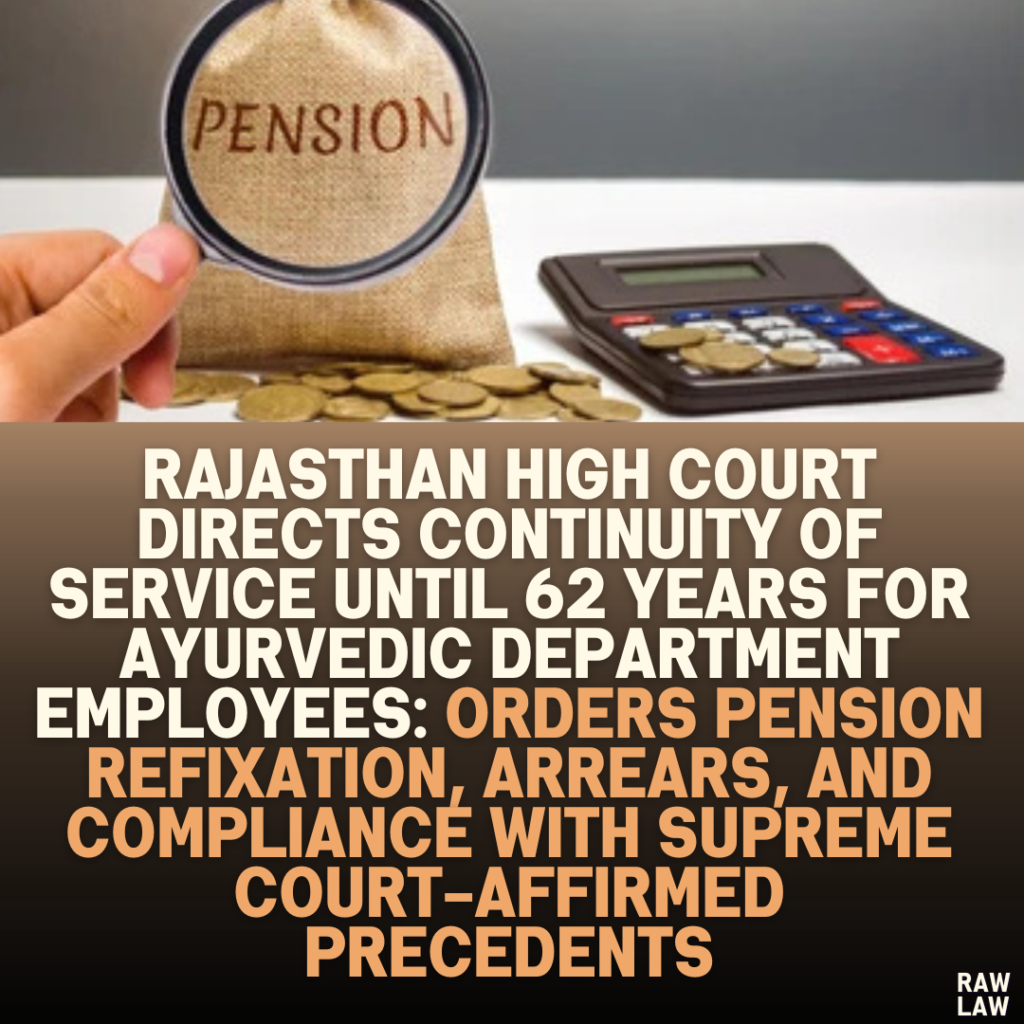1. Court’s Decision
The Rajasthan High Court disposed of the petition and directed the government to treat the petitioners as having continued in service until they attained the age of 62 years. It ordered the respondents (state authorities) to:
- Issue necessary orders confirming the continuity of service for the petitioners until 62 years.
- Refix pensions and other post-retirement benefits.
- Take all consequential actions, such as paying arrears, to ensure compliance with the High Court’s earlier judgment upheld by the Supreme Court.
The court aligned its decision with its earlier ruling in the case of Dr. Mahesh Chandra Sharma v. State of Rajasthan & Ors., which was upheld by the Supreme Court.
2. Facts
- The petitioners, retired employees of the Ayurved and Bhartiya Chikitsa Vibhag (Ayurvedic and Indian Medicine Department), sought clarity regarding their retirement benefits.
- The matter came before the court following two significant developments:
- The Supreme Court dismissed the review petition in the case of Dr. Mahesh Chandra Sharma v. State of Rajasthan on October 15, 2024, affirming the Rajasthan High Court’s decision regarding the service continuation of similarly placed employees.
- The Supreme Court, in State of Rajasthan v. Pyare Lal Meena, clarified that there was no stay on the High Court’s ruling and directed that any outstanding salary dues be cleared within a week.
- The petitioners contended that they were similarly placed to the litigants in the aforementioned cases, as they had also crossed the retirement age of 62 years.
3. Issues
The key issues before the court were:
- Should the petitioners be deemed to have continued in service until the age of 62?
- Are they entitled to the consequential benefits of service continuation, such as pension recalculations, arrears, and other post-retirement benefits?
4. Petitioner’s Arguments
- The petitioners cited the High Court’s previous decision in Dr. Mahesh Chandra Sharma and the Supreme Court’s affirmation of that judgment. They claimed they were similarly situated to those petitioners.
- They argued that the Supreme Court’s clarification in Pyare Lal Meena established that there was no stay on the earlier High Court ruling, reinforcing their claim for continuity of service until the age of 62.
- They sought relief to ensure parity in treatment with other employees who had benefited from the court’s decisions.
5. Respondent’s Arguments
- The respondents (State authorities) opposed the petitioners’ claims but provided no substantial counterarguments to distinguish their case from the earlier judgments in Dr. Mahesh Chandra Sharma and Pyare Lal Meena.
- Their arguments did not effectively challenge the applicability of the precedents cited by the petitioners.
6. Analysis of the Law
- The court examined its earlier decision in Dr. Mahesh Chandra Sharma, where it ruled that employees must be deemed in service until 62 years and entitled to all consequential benefits, including pension refixation.
- It also considered the Supreme Court’s directions in Pyare Lal Meena, which clarified that there was no legal impediment to enforcing the High Court’s judgment and directed that unpaid salaries be cleared promptly.
- The principles of equality and consistency in applying the law were central to the court’s analysis, emphasizing that similarly placed employees should receive identical treatment.
7. Precedent Analysis
- Dr. Mahesh Chandra Sharma v. State of Rajasthan:
- The High Court ruled that employees should be deemed in service until 62 years of age, with associated benefits like arrears, pension recalculations, and continuity of service.
- This decision was upheld by the Supreme Court when it dismissed the review petition.
- State of Rajasthan v. Pyare Lal Meena:
- The Supreme Court clarified that there was no stay on the High Court’s judgment and directed payment of outstanding salaries within a week, reinforcing the High Court’s ruling.
8. Court’s Reasoning
- The court observed that the petitioners’ situation was identical to those addressed in the earlier judgments. Denying them similar relief would lead to unequal treatment among employees in the same category.
- The court noted that the absence of a stay on its earlier judgment confirmed its enforceability.
- It emphasized the need for administrative compliance with court orders to ensure uniform application of the law and prevent injustice.
9. Conclusion
The High Court concluded that:
- The petitioners are deemed to have continued in service until the age of 62 years.
- The respondents must pass necessary orders to reflect this continuity, recalculate pension benefits, and pay arrears.
- All consequential actions, including the adjustment of retirement benefits, must be completed promptly.
10. Implications
- The judgment reaffirms the principles of uniformity and equality in service-related matters, ensuring that similarly placed employees receive identical treatment.
- It sets a strong precedent for enforcing court orders and ensuring compliance by government authorities.
- The decision will impact other cases involving service continuation, pension recalculations, and parity in employee benefits in Rajasthan.
